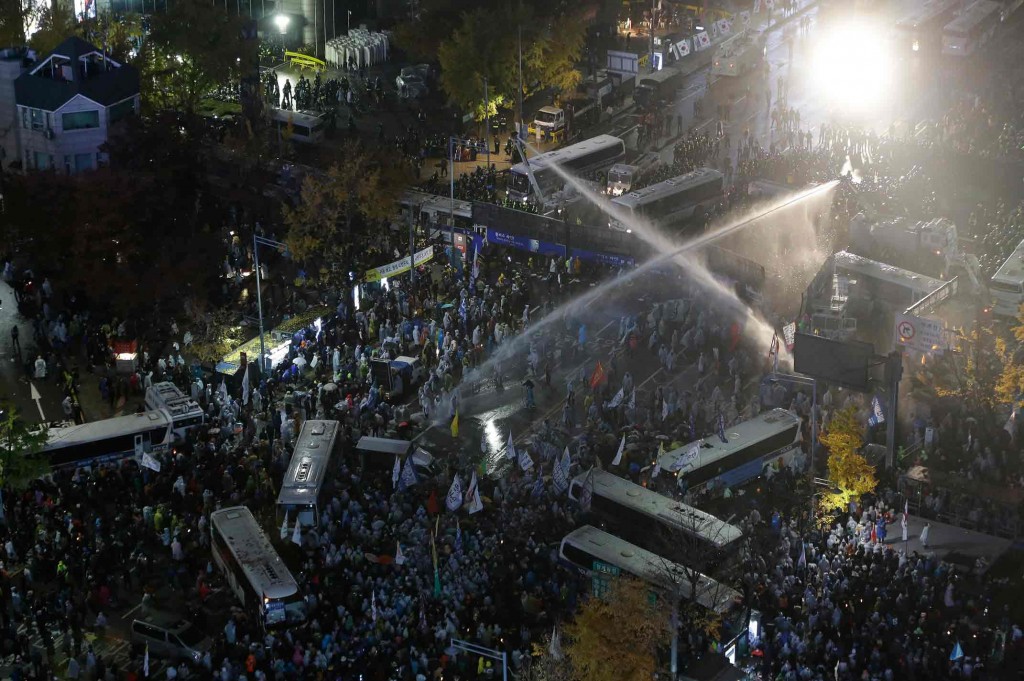- California Assembly OKs highest minimum wage in nation
- S. Korea unveils first graphic cigarette warnings
- US joins with South Korea, Japan in bid to deter North Korea
- LPGA golfer Chun In-gee finally back in action
- S. Korea won’t be top seed in final World Cup qualification round
- US men’s soccer misses 2nd straight Olympics
- US back on track in qualifying with 4-0 win over Guatemala
- High-intensity workout injuries spawn cottage industry
- CDC expands range of Zika mosquitoes into parts of Northeast
- Who knew? ‘The Walking Dead’ is helping families connect
Blame game ensues after S. Korean protest goes violent

South Korean riot police officers spray water cannons as police officers try to break up protesters trying to march to the Presidential House after a rally against government’s policy in Seoul, South Korea, Saturday, Nov. 14, 2015. Police fired tear gas and water cannons Saturday as they clashed with anti-government demonstrators who marched through Seoul in what was believed to be the largest protest in South Korea’s capital in more than seven years.(AP Photo/Ahn Young-joon)
By Lee Kyung-min
Tension is escalating between police and protesters over who should be held accountable for Saturday’s rally that left one protestor unconscious and more than 140 people injured ― 113 police officers and 29 rally participants.
While protestors criticized police for the violent crackdown in which water cannons were used with spray containing capsaicin, police claim the measure was necessary because protestors attempted to topple police buses and attack officers with metal pipes and sharpened bamboo sticks.
From Saturday afternoon, tens of thousands of people from 53 civic, labor and farmer’s groups staged a 12-hour rally to protest the government’s “mishandling” of various issues such as a state-authored history textbook, labor reform, and youth unemployment, among others. The prosecution has sought arrest warrants against eight people who were booked for violating laws of public protest, obstruction of business. Initially 49 people were booked on Saturday.
During the rally, a member of a farmer’s union, surnamed Baek, 69, was critically injured after being hit by a water cannon. He underwent surgery but remains in critical condition.
On Monday, organizers of the rally, including the nation’s largest umbrella union, Korean Confederation of Trade Unions (KCTU), held a press conference demanding the dismissal of National Police Agency (NPA) Commissioner General Kang Sin-myeong, and an official apology from President Park Geun-hye, in front of the NPA building in central Seoul.
“Police kept on firing the water cannon at Baek who fell to the ground,” they said. “Police are supposed to protect and serve the public. How can they do this?”
They said that Baek is unconscious due to the brutality of the water cannon attack. “Who gave them such an order? President Park should return to Korea from her overseas trip and duly punish those who are held accountable,” they added.
The rally organizers said they will hold a second rally on Dec. 5.
Earlier in the day, Kang vowed to harshly punish protestors who used violence, saying that they will face criminal charges for violence and civil charges for damage done to property and people.
“On Saturday, some of the protestors wearing hoods and masks swung metal pipes and threw stones at police,” Kang said during a teleconference with regional police agency heads.
He said the police will trace those who lead these violent acts based on video shot at the scene. He added that each regional police agency will have special teams against violent demonstrations, saying not only individuals using violence but groups they belong to will be subject to investigation.
While expressing regret toward Baek, Kang said, “Further investigation is needed to establish the facts of what happened and how. But in any case, the injury cannot justify the violence of the protestors. The police’s proper and legal exercise of power should be protected.”















